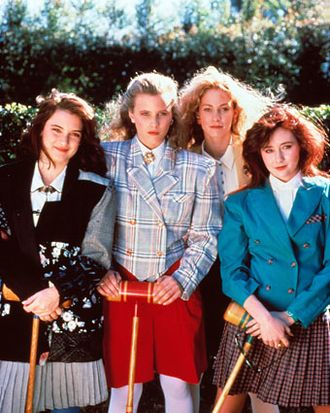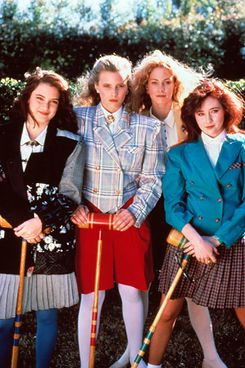

Today we begin a new feature on Vulture, the Nostalgia Fact-Check, in which we will revisit a seminal movie, TV show, or album that reflexively evinces an “Oh my God, that was the best ever!” response by a certain demo when mentioned in conversation, owing to it having been imprinted on them early. Now, years later, we will take a look at these classics in a more objective, unforgiving adult light: Are they really the best ever? How do they hold up now? Our first installment: Heathers.
Background: Released in 1988, Heathers starred Winona Ryder as Veronica Sawyer, the slightly conscience-stricken member of Westerburg High’s clique of extremely popular, extremely mean girls named Heather. Under the influence of her alluring and psychopathic new-boy-in-town boyfriend, Jason Dean (Christian Slater), Veronica starts murdering — or aiding in the murder of — her horrible, popular classmates and making it look like suicide. The film made almost no money on its release but played regularly on cable and became a cult classic. Its reputation rests on its aggressive, quotable slang (“What’s your damage, Heather?” and “Fuck me gently with a chain saw” being two of the more memorable lines), colorful costumes (girls in color-coded croquet outfits; the best use of a monocle by a teenager in movie history), and a bracing, satirical if-you-think-adults-are-horrible-check-out-these-teenagers sense of nihilism.
Nostalgia Demo: Anyone between the ages of five and 35 when Heathers was released: the latter because they liked it immediately, the former because they grew into it as it played on cable TV throughout the nineties.
Fact-Check: If you haven’t seen Heathers in a while, you almost have to watch it twice, just so you can spend the first viewing doing what comes naturally: thinking in an endless loop, eyes wide and mouth agape, I can’t believe this movie got made, this movie could never get made now; I can’t believe this movie got made, this movie could never get made now … (The second time around, you can just revel in the camp of the opening shot: a close-up on the red scrunchie of power. When are those making a comeback?) A brief list of events in Heathers that would be impossible to imagine getting okayed by a studio in today’s post-Columbine, post- 9/11 world: the romantic lead bringing a gun to school, shooting blanks in his classmate’s faces, and not even being suspended; the consequence-free murder of one’s classmates; the heroine shooting a classmate in the chest in cold blood; a boy trying to blow up his school, and, when foiled, blowing himself up with a suicide-bomber vest. (To be fair, in the original screenplay, JD blew up the school and everyone ended up at a prom in heaven: The studio balked at that ending even then.) As JD says, and he might as well be talking about the movie that created him, “The extreme always seems to make an impression.”
Heathers’ prescience has served it well: Its hot-button concerns — teen suicide, bullying, and school shootings — are as toasty today as they were then (no passé warnings about the dangers of angel dust here), but it’s the superficially flip manner with which it treats those subjects that really stands out. Heathers doesn’t do heartwarming messages. Glee is modeled on Heathers in so many ways — from the evil of the popular people, to the zingers, to closeted bully Karovsky — but when the TV show is held up next to its forerunner, the feel-good Glee feels like a tour through a Hallmark card factory. Granted, Glee looks like a Hallmark card factory when compared to a Hallmark card factory, but even the willfully edgy Mean Girls and Gossip Girl are earnestly committed to portraying socially positive values — to being loyal, to being yourself, to standing up to bullies — in an uncomplicated way that Heathers would scoff at. While you can see some of Heathers’ influence in modern teen movies, John Hughes’s movies (which always had a warm-and-fuzzy takeaway) and Beverly Hills 90210 (which debuted a year later with former Heather Shannen Doherty and ticked off “social issues” like there were on a laundry list) have had a more lasting influence on the ethics, if not the style or basic premise (high school is nasty), of teen-centric entertainments. Heathers has a worldview that is basically nihilist: There is not much good, and insofar as Veronica is our hero even though she’s also a murderer, there really isn’t any bad either.
This caustic, unrepeated sensibility keeps Heathers feeling fresh, though today some of its moves feel like missteps. Take the “I love my dead gay son” moment, below, which stands out far more now than it would have on the movie’s release. Veronica and JD have just murdered two horrible jocks, Ram and Kurt, and made it look like the pair killed themselves because they were gay and in love. (A bottle of mineral water was left at the scene of the crime as evidence of their sexual preference; now there’s a homosexual stereotype that has gone by the wayside.) At the funeral, Kurt’s father gives a speech about loving his son unconditionally that ends with “I love my dead gay son.” In a time of “It gets better” videos and Tracy Morgan having to go on a penitence tour for his homophobia, the extent to which this moment, like everything in Heathers, is played satirically, now feels jarring.
Not that Heathers wasn’t jarring when it was released. When I was a teenager, Heathers freaked me out, while I religiously watched 90210. They both took on similar teen topics, though 90210 did it in a far more melodramatic manner. Early in its run, it also had a gun-violence episode, in which David Silver’s uncool childhood friend Scott Scanlon accidentally killed himself playing with a handgun. In a melodramatic speech accidentally broadcast to the whole school, David tells Brandon he’s sick of hearing all the platitudes about Scott: “It doesn’t matter what you say about someone once they’re gone. What matters is how you treat them when they’re still here.” Veronica would roll her eyes, amending, “It shouldn’t matter what you say about someone once they’re gone. But here we are.” After all, Heathers is all about how dying really can change your life. As Veronica says, “Suicide gave Heather depth, Kurt a soul, and Ram a brain.” Veronica is smarter than David Silver, but I’ve probably thought about that ridiculous David Silver speech more than I’ve ever thought about any of the deaths in Heathers.
In the recent “Deep Focus” book on Heathers by John Ross Bowie, screenwriter Daniel Waters says about the movie’s reception, “People in their 20s and their early 30s, they respond to the movie right away, Teenagers, you know, it was 50/50 … it’s the only movie I know that people really like, but the first time they saw it, they hated it.” Anecdotally, I’d say this is right: Most of the people I know who loved Heathers while still in high school had an older sibling, relative, or friend telling them how cool it was. The cheese-ball messages of 90210, and to a certain extent the John Hughes movies, haven’t aged as well as Heathers, but the almost operatic earnestness with which that show treats the life or death drama of being a teenager is much more comforting and complimentary than Heathers, which treats the life or death drama of being a teenager as its main joke.
Not that the precocious, mature Veronica and JD even act much like teenagers. At one point Veronica complains to JD that she hates her friends, “They’re people I work with, and our job is being popular and shit” — said like the office drone that Veronica has never been. Whereas other teenage protagonists hem and haw and spend entire crazy nights trying to lose their virginity, the first time Veronica and JD hang, they bang. (Chuck Bass has a similar attitude, and, at times, a cruel streak JD would recognize.) JD and Veronica are so intense that when they fight she burns her hand on a car cigarette lighter and JD lights his cigarette off her hand. All Dylan McKay did was throw a flowerpot!
But though the way the Heathers characters talk and behave may feel precocious, it’s quickly forgiven because the move is so hilarious and timelessly quotable. The main reason that Heathers has aged so well is the banter. Much like Clueless, it created its own slang, which stands up far better than any based on a more historically accurate syntax. The lines make Westerburg High seem like a fully realized, if totally isolated, world. (Especially great is the use of “very.” As in, “That’s so very.” Let’s bring it back.)
The performances stand up, too. As David Edelstein already noted, Kim Walker (Heather Chandler) is an all-time queen bitch, crueler, smarter, and more sadistic than everyone who’s come since. Shannen Doherty was still best known as a sweet girl from Little House on the Prairie when she got the part of Heather Duke. She’s not exactly good here, but watching her struggle to get her bitch on, with full knowledge of how well she would eventually master it on 90210, is funny in the same way that watching little kids play hide and seek is: They’re missing what’s right in front of them. And then there’s Ryder and Slater, both so young and dewy, with charisma to spare. They both deserved to be movie stars, which is a poignant thing to be reminded of, now that they’re not. (Also, shoplifting when you don’t have to: something Veronica Sawyer would do, true or false?) Ryder is especially wonderful, so inherently likable that she makes you want to defend her horrible choices (she didn’t want to kill Kurt!) and working the quirk (that monocle, those shoulder pads, the excessive diary writing) without letting the quirk work her. Zooey Deschanel, take notes?
Heathers holds up in one other entirely unexpected way: The plot could work in an Internet age quite easily. The notes that the girls use as instruments of torture could just as easily be text messages; Veronica’s diary sure seems like a blog; Heather Chandler’s suicide note makes the rounds just like an e-mail; and all that bullying. Though, please, powers that be, don’t take this as a recommendation for a remake. The original is very enough.
Next week in the Nostalgia Fact Check: Ally Mcbeal!

